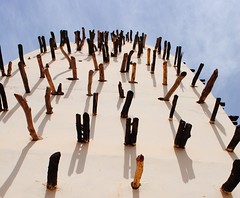On a low: Only 5km into our day of cycling and a huge thorn has buried itself within the depths of Mikaela’s front tyre and is causing multiple punctures. Time for a new tyre.

Mikaela gives her new tyre the kiss of luck!
On a high: A long day of pedalling and we arrive at an actual hotel. As students on bicycles we are swiftly shown to a cheap spot on the roof… we discover the hotel has a swimming pool and sneak lots of cheeky dips free of charge.

A blissful afternoon off the bikes…
On a low: Discovering the rumours were wrong, the road had not been paved as far as hoped…

The signpost gave little detail as to what the ‘danger’ was…
On a high: We rest our piste-shaken bones in the small village of Tedie Kanda. It’s an artisan village of Dogon people and we are invited to meet the local weavers at work.


Hard at work weaving cloth
On a low: The dust is bad and the borderland is much bigger than the map told us.

It should have been 15km…

An orange mist
On a high: At the Malian exit point, we worry about our dodgy visas (Imran was mistakenly given a 100 years duration). But it seems the officials are so happy we took the road against the advice of ‘evil Sarkozy’ (we assume a reference to the kidnap warning recently issued by the French Embassy for this particular road), they offer us tea and barely even glance at our invalid visas.

Sharing a glass of tea
On a low: We cycle past a truck accident, no one is hurt but there is fuel all over the road. It coats the tyres in a greasy layer and we nearly fall of our bicycles trying to brake, we then have to clean it off before heading down a bit of a hairy hill…

Scary stuff
On a high: We reach Ouahigouya and the end of the piste, smooth tarmac stares us in the face and a friendly ‘ça va?’ calls out from next to a cart full of mangoes, we lean the bikes against a signpost for cold coca cola, time for a break…















